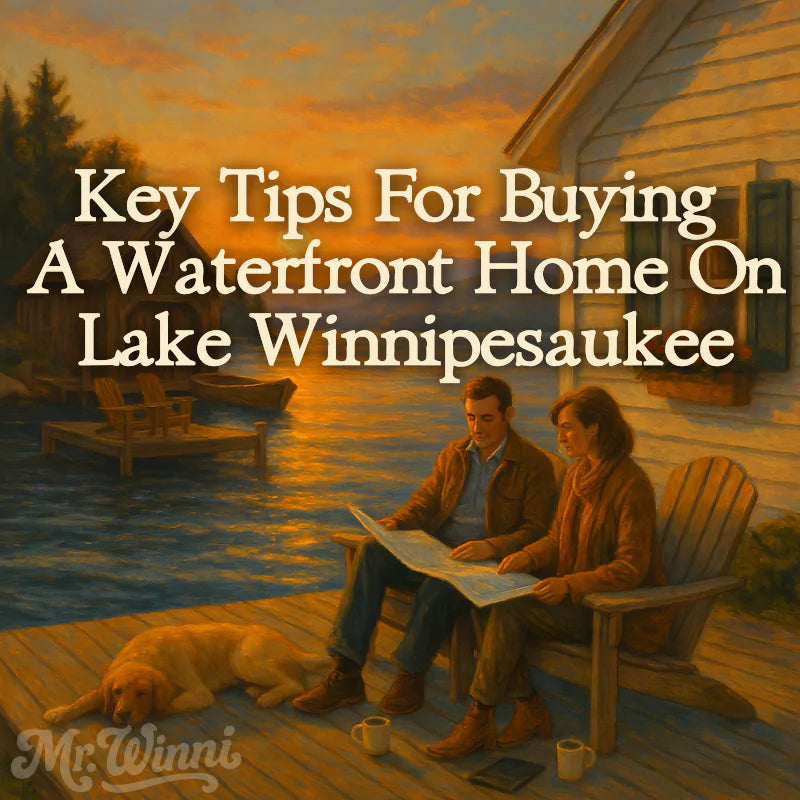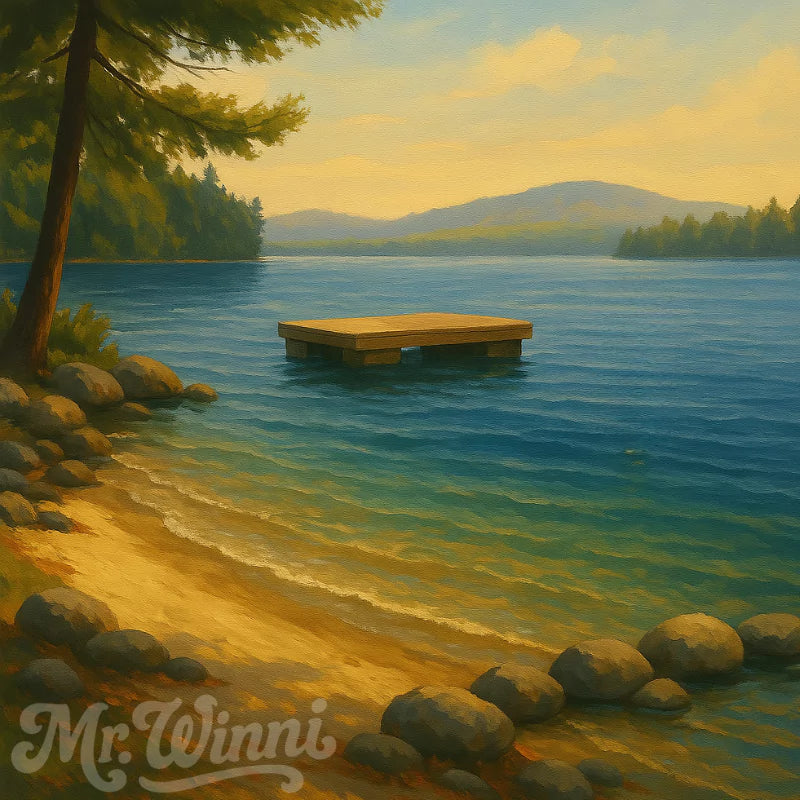Key Tips for Buying a Waterfront Home on Lake Winnipesaukee

Buying a waterfront home on Lake Winnipesaukee is a dream for many – waking up to sparkling water views, having your own dock, and enjoying endless lake fun. However, purchasing lakefront property comes with unique considerations that differ from a typical home purchase. Before you dive in (pun intended), arm yourself with these key tips to ensure your Winnipesaukee waterfront purchase is a success. From understanding regulations to assessing the shoreline, these tips will help you navigate the process like a savvy local.
Owning a waterfront home often means inheriting structures like boathouses and docks. It’s essential to inspect these and understand permit rules. In the image, a classic wooden boathouse extends over the water – a charming feature that comes with maintenance responsibilities and regulatory considerations on Lake Winnipesaukee.
Learn the Shoreland Rules and Regulations.
Lake Winnipesaukee’s shoreline is protected by state environmental regulations to preserve water quality. Before buying, familiarize yourself with New Hampshire’s Shoreland Water Quality Protection Act. This law restricts what you can do within 250 feet of the lake – for instance, there are limits on adding impermeable surfaces, removing trees, or expanding structures close to the water. If the property needs renovations or you dream of adding a patio by the shore, know that permits will be required.
Check if the property comes with any previous permits or variances, and consider hiring a land-use consultant or speaking with the NH Department of Environmental Services to understand the feasibility of your plans. The last thing you want is to buy a waterfront home and then discover you can’t build that extra gazebo or guesthouse due to regulations.
Inspect Existing Waterfront Structures (Dock, Boathouse, etc.)

A huge perk of a lakefront home is having your own dock or even a boathouse. These structures are valuable – but also subject to rules and wear-and-tear. When touring a property, closely inspect the dock’s condition: is it wood or metal? Permanent cribs or seasonal dock? Look for warping, rot, or damage from ice. Docks can be expensive to repair or replace, so you’ll want to factor that in. Similarly, if there’s a boathouse or waterfront deck, check its structural integrity. Importantly, ask the seller for proof of state permits for these structures. Docks should have a permit on file, and if you plan to modify or expand one, you’ll need to apply for a new permit. New boathouses over the water are generally no longer permitted, so an existing one is grandfathered – treasure it and know you’ll be responsible for maintaining it. If the property lacks a dock, research if adding one is possible (you’ll need sufficient frontage and state approval, which isn’t guaranteed in tight coves or environmentally sensitive areas).
Evaluate Water Depth and Lake Bottom at the Shoreline.

Not all waterfront is created equal. Some properties have a sandy beach and deep water, others have rocky or shallow frontage. Think about how you plan to use the water. If you have a large boat (or plan to get one), you’ll need adequate depth at the dock – ideally 4+ feet of depth – and minimal rocks. Shallow, weedy areas might only be good for small boats or kayaks and can become mucky in late summer. Ask about the lake depth off the end of the dock (many listings will mention “deep-water docking” if they have it). Also, walk the shoreline if possible: is it a gentle sandy entry (great for kids to wade and swim) or does it drop off quickly? Is the bottom sandy, pebbly, or silty? A sandy bottom is ideal for swimming. If the bottom is mucky or full of leaves, it might indicate a cove that doesn’t flush well – this can lead to more aquatic plants like milfoil. Milfoil is an invasive weed present in some areas of Winnipesaukee; check if the cove or bay has had milfoil treatment. While milfoil is manageable, it’s good to know if the swimming area needs occasional cleaning out.
Consider Sun Exposure and View Orientation.

The orientation of a waterfront home significantly affects your experience. As mentioned earlier, western-facing properties capture long afternoon sun and sunsets – highly desirable for many (sunset cocktails on the dock, anyone?). Eastern-facing properties get morning sun and cooler afternoons (great if you prefer shade in the hot summer evenings). Think about your personal preference: do you love watching sunsets or are you an early riser who’d enjoy sunrise views? Also consider view – what are you looking out at? Open lake with long views of islands and mountains is premium. Some properties might face a narrow channel or marsh across the way – more privacy, but maybe not the classic “big lake” view. Additionally, houses on the north side of a peninsula may get more breeze (which can be good for keeping bugs away) but could be cooler; south side can be warmer. If possible, visit the property at different times of day to see the lighting and feel the microclimate.
Check for Year-Round Accessibility.

If you plan to use the home in winter or even visit in the off-season, ensure you can access it year-round. Many lake homes are on private roads or associations. Key questions to ask: Is the road plowed in winter and if so, by whom (town or private)? If private, is there an annual fee for road maintenance and snow removal? Some smaller lanes might not be maintained, meaning you’d have to snowmobile in during deep winter – that might be a fun adventure for some, or a deal-breaker for others.
Also, what about utility access? Most areas around Winnipesaukee have power, internet, etc., but a few remote stretches might not have high-speed internet – important if you plan to work from home. If the home is on an island or very remote peninsula, consider logistics like parking and boat storage. Island properties require a boat ride to get to your home – idyllic in summer, but come spring thaw or late fall, you’ll need to coordinate closely with weather and possibly have a second mainland spot for your car/boat.
Understand Septic and Water Systems.
Lakefront homes often aren’t connected to municipal sewer or water; they rely on septic systems and wells (or lake water). It’s critical to know what the property has and the state of those systems:
-
Septic: Ask for the septic system details – how old, what size (tank capacity and how many bedrooms it’s rated for). A lot of older camps have undersized or outdated septics. An undersized septic can limit your ability to add bedrooms or expand the home, since any addition usually requires showing septic capacity. If it’s an old cesspool or steel tank, budget for a replacement. Also, since we’re protecting lake water quality, a modern septic in good working order is important. During your inspection, have a septic inspection with pumping to ensure it’s functioning properly.

- Water Supply: Determine if the house has a drilled well, a shallow dug well, or draws water from the lake. Many older lake homes use lake water for irrigation or even for the home (with filtration). Lake water systems must be winterized (pumped out) before freezing and can’t be used for potable water without treatment (and even then, many opt for drinking bottled water). A drilled well is a plus for year-round reliable water. If a well isn’t present, factor in costs/feasibility of drilling one. Also, water quality tests are a good idea – iron, sulfur, or other minerals can sometimes be an issue in wells around the lake.
Research Flood Zones and Insurance.
While Winnipesaukee’s level is managed by a dam and doesn’t have frequent catastrophic floods, some low-lying shoreline areas can experience high water in spring. A few homes sit in spots that could be considered flood zones (especially if they’re at lake level with little elevation). Check FEMA flood maps or ask your lender if flood insurance is required for the property. Even if not required, note if the shoreline shows evidence of past high water (watermarks on trees or retaining walls). Also consider storm waves – is the property in a protected bay or on an exposure that gets big wind and waves? High spring winds can send waves crashing; many owners install rock rip-rap or breakwaters to protect their shore. Make sure any such structures are permitted and in good shape. If extra insurance is needed (for example, for that boathouse or for flood), get quotes during due diligence so there are no surprises in cost.
Budget for Maintenance
(It’s More Than a Normal Home). Waterfront homes often have higher ongoing maintenance needs:

- Exterior upkeep: The proximity to water can cause more wear on paint and materials. Wood decks and siding might need staining more often due to sun and moisture. Metal can corrode faster. Plan on diligent upkeep to preserve that beautiful home – it’s worth it!
-
Dock removal/storage: If it’s a floating or removable dock, you’ll need to take it out before winter ice (and put in each spring). Many owners hire local services for this if they can’t do it themselves. That’s an annual cost to include.
Bubblers or Ice Protection: If you have a permanent dock or boathouse, you may need a de-icer (bubbler) system to keep ice from crushing it. This uses electricity to circulate water around the structure. You’ll want to budget for the power usage and maintenance of that system in winter. - Landscaping and Shoreline: Maintaining a shoreline within shoreland rules can be tricky – you can’t just clear-cut vegetation. Many hire landscapers familiar with lake properties to manage lake-friendly landscaping (like rain gardens or buffer plants) that both look nice and protect the lake. Also, watch for erosion. If a section of shoreline is eroding, you might need to address it with proper permits.
-
Boat and Toys: While not house “maintenance,” owning a waterfront means you’ll likely invest in boats, jet skis, kayaks, etc. Don’t forget to budget for the fun stuff like boat storage in winter, gas, registration fees, and maintenance of your watercraft and dock equipment (lifts, canopies).
Look into Lake HOA or Association Rules (if applicable).
Some waterfront homes are part of an association or private community, especially if they share amenities like a beach or road. Examples include communities like Suissevale or Balmoral in Moultonborough, or condos with shared waterfront. These will have covenants and rules – sometimes including restrictions on rentals (e.g., minimum 1-month lease), pets, dock usage, etc. They also come with fees. Read those documents thoroughly to ensure they align with your plans. On the flip side, being part of an association often means amenities and services: they might maintain the roads, have dumpsters for trash, shared beaches, or even a clubhouse. That can enhance your lake life and ease some burdens.
Work with Local Experts.
Perhaps the most important tip: use local professionals during your purchase. A local real estate agent who knows Winnipesaukee can identify potential red flags (like a notoriously shallow bay or a property with unclear dock rights) and guide you to good deals. Local home inspectors with lake property experience will check things a general inspector might miss (like winterization systems, lake water pumps, etc.). Surveyors can clarify lot lines (valuable if there are shared access paths or questions on waterfront footage). And local lenders/insurance agents understand the nuances of waterfront financing and coverage.

Even after purchase, get to know your lake neighbors – they’re often a wealth of knowledge on everything from the best contractors to how to get involved in the annual Lake Host program that protects against invasive species. As one long-time lake resident put it, you want to “build a team” – realtor, lawyer, inspector – who’ve done the Winnipesaukee waterfront dance many times.
In Conclusion.
Buying a waterfront home on Lake Winnipesaukee is more complex than buying a regular house inland, but the reward is arguably much greater. You’re not just buying a home, you’re buying a lifestyle of sun-soaked afternoons on the dock, evening cruises with family, and waking up to water views that feed your soul. With these tips in mind, you’ll be prepared to tackle the extra due diligence needed.
One final piece of advice: Don’t rush. Waterfront inventory can be limited and competitive, but it’s worth taking the time to find a property that checks your boxes and doesn’t come with hidden problems. When you do find “the one,” all this preparation will pay off as you move in with eyes wide open and confidence that you made a smart purchase.
For further reading For further reading, be sure to explore our Lake Winnipesaukee Real Estate Investment & Rental Guide. It covers how to generate income from your lake home and navigate rental regulations – perfect if you’re thinking of offsetting costs by renting your property when you’re not using it. With these tips and the right team of local experts on your side, you’ll be well on your way to securing the waterfront home of your dreams on Lake Winnipesaukee. Happy home hunting, and welcome to the lake life! - Mr. Winni

